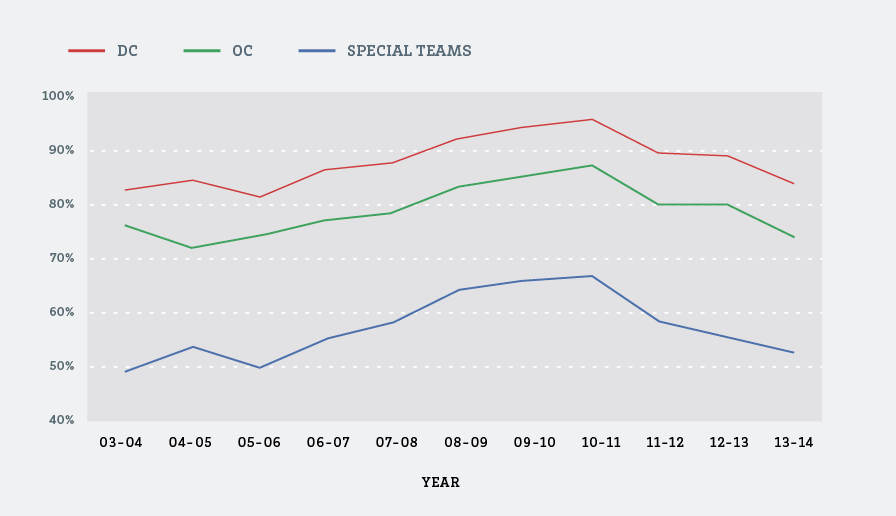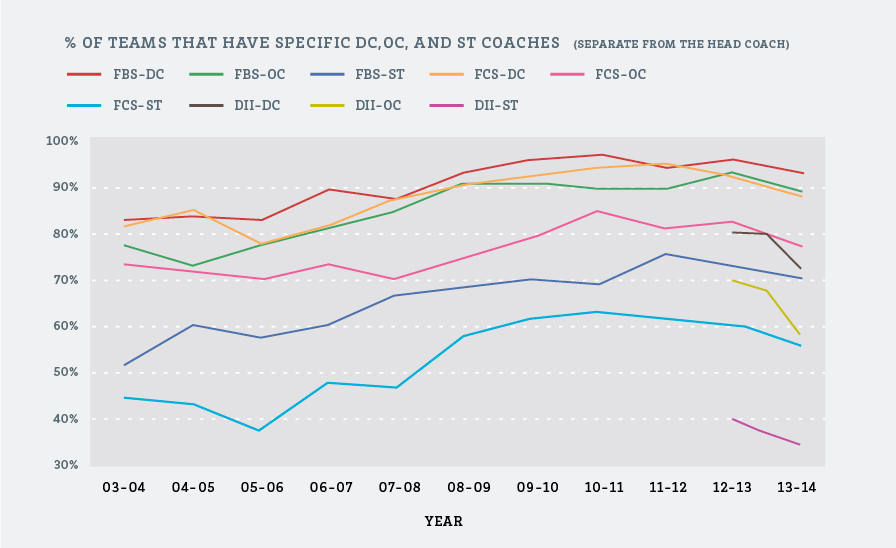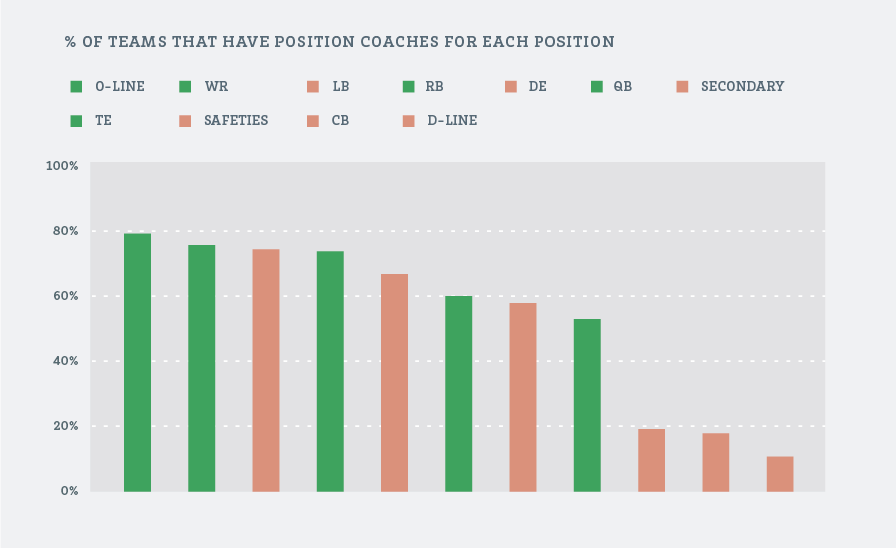Key Takeaways
- There was an increase in the percentage of teams that had Defensive, Offensive, and Special Teams Coordinators until 2010-11, but the number has declined in the past three seasons.
- More Offensive-Line coaches are employed in all divisions than any other position coach. However, whereas Wide Receivers, Linebackers, and Running Back coaches take up spots 2-4 – we found this to be the case on over 85% of FBS teams, and 75% of FCS teams – the second most popular position coach in D-II is Defensive End, found on 67% of teams.
- The biggest discrepancy between divisions is with Tight End position coaches, which are found on 70% of FBS teams, 52% of FCS teams, and just 28% of D-II teams.
The ways that head coaches set up their coaching staffs are dictated by numerous factors: NCAA regulations, athletic department funds, and coaching philosophy to name a few. We’ll take a look at some general trends among coaching staffs at the D-I FBS, D-I FCS, and D-II levels. Using the Win AD database, containing contracts for nearly 6,200 coaches spanning nearly 30,000 coaching years over the last eleven seasons, we found the following:
While some Head Coaches act as their own Defensive, Offensive or Special Teams Coordinator, more teams are likely to have a separate DC than OC, and much more likely to have either of those than a separate Special Teams Coordinator.
There was an increase in the percentage of teams that had DC’s, OC’s, and Special Teams Coordinators up until 2010-11, but that number has declined in the past three seasons. Additionally, roughly 45% of teams employ a Director of Operations.
As expected, teams at the FBS level are more likely to employ DC’s, OC, and Special Teams Coordinators, at an average of 91%, 85%, and 66%, respectively. Teams at the FCS level employ about the same percentage of DC’s (88%), but around 9% fewer OC’s (76%), and 13% fewer Special Teams Coordinators (53%). D-II teams employ such individual coaches 78%, 65%, and 37%, respectively.
% of Teams that have specific OC, DC, and ST Coaches (separate from the Head Coach)
When we look at position coaches, the offensive side of the ball seems to get more attention than the defensive side.
% of Teams that have position coaches for each position
While the labels for the defensive-side position coaches are much more fluid than the offensive side (a team might not feel the need to have both a D-Line and DE position coach, or both a Safety and CB coach), the overall percentage of teams that employ position coaches is noticeably greater on the offensive side of the ball.
Broken down by division, the percentages are relatively the same in each. More O-Line coaches are employed in all divisions than any other position coach. However, whereas Wide Receivers, Linebackers, and Running Back coaches take up spots 2-4 – we found this to be the case on over 85% of FBS teams, and 75% of FCS teams – the second most popular position coach in D-II is Defensive End, found on 67% of teams. The biggest discrepancy between divisions is with Tight End position coaches, which are found on 70% of FBS teams, 52% of FCS teams, and just 28% of D-II teams.
In looking at the three Coordinator jobs, the majority of them have position responsibilities as well. Of the 7,589 coaching seasons we examined, 80.6% of Special Teams coaches, 68.1% of Offensive Coordinators, and 49.6% of Defensive Coordinators were position coaches as well. (There are a few coaches that hold dual roles as both OC and ST, or DC and ST, but that’s relatively rare – just one coach was an OC and ST for one year, and just 12 coaches were DC and ST in the 27 seasons.) Most of these dual responsibilities were a Coordinator + 1 position, but a small number (3.7%) hold Coordinator responsibilities and multiple positions.
Looking at the offensive side, nearly 60% of the OC’s were also the QB position coach. Another 20% were O-Line position coaches, while WR, RB, and TE position coaches made up the other 8.5%, 6.9%, and 4.1%, respectively. QB+WR and QB+RB made up nearly 60% of the double-position responsibilities, but other combinations of O-Line+TE, O-Line+RB, RB+TE, RB+WR, TE+WR, and QB+TE were also represented. Interestingly, in one case an OC also was the Linebacker position coach for two seasons.
On the defensive side, nearly 50% of the DC’s were also the LB position coach. Another 27% were Secondary position coaches, while Safeties, D-Line, CB, and DE made up the other 12.6%, 8.4%, 1.9%, and 0.8%, respectively. Again, because the defensive positions are more fluid, there weren’t too many coaches who’s titles included more than one position role – just four were LB+Secondary position coaches for 11 seasons, while one was a DE+LB+Safeties coach in addition to being DC for five seasons. Interestingly, one coach was also the QB position coach and a DC for three seasons, while one was a WR position coach while DC for one season.
Finally, Special Teams coaches have held position responsibilities on both sides of the ball, but a few more (53.3%) are on the defensive side of the ball. Of the ST coaches that hold defensive position responsibilities, 38.1% are LB coaches, 23.6% are Secondary coaches, and 17.2% are D-Line coaches. Less than 10% are coaches for Safeties, and less than 5% are coaches for CB and DE. Of the ST coaches that hold offensive position responsibilities, 37.9% are TE coaches, 33.5% are RB coaches, and 22.4% are WR coaches. Less than 2% are coaches for the O-Line or QB’s.






